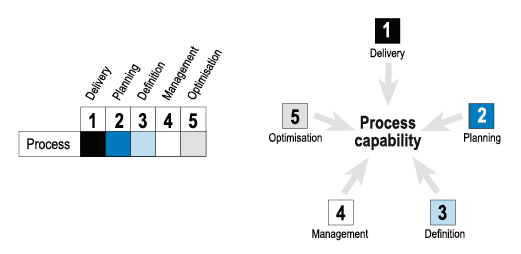Overview of eMM
| Change with digital technologies in education (#OERuCDTE) | |
|---|---|
| E-Learning Maturity Model | Introduction and objectives | Video signpost | Overview of eMM | e-Activity - e-Learning processes | Dimensions | e-Activity - Mindmap and mini-evaluation | e-Activity - eMM evaluation |
The eMM originated from theories in organisational capability maturity and SPICE (Software Process Improvement and Capability dEtermination)[1]. The model has been refined and improved over the last decade involving international workshops, research and more than one hundred institutional evaluations. The eMM includes three structural elements: e-learning processes, dimensions of maturity and capability assessments.
Contents
Processes
Processes refer to the activities which contribute to the quality of e-learning, for example, providing mechanisms for interaction of students with teaching staff and fellow learners. The processes used in eMM were derived from the research literature on the quality of e-Learning, international consultations with practitioners and eMM assessments using earlier versions of the model.The eMM has identified thirty-five processes which are divided into five categories. Each process defines an aspect of the ability of an organisation to perform well in the respective process area. The rationale of this approach is to break down the complexities of e-learning work into related sections that can be assessed independently and then presented in a comparatively simple overview without losing the underlying detail.
Dimensions
Organisational maturity theories usually describe the progression of an organisation through a series of maturity levels, for instance, starting as an immature organisation and then progressing through a number of maturity phases towards optimisation and continuous systems improvement.The eMM differs from traditional maturity theories. Rather than measuring progress through phases or levels, it describes the capability of a process from multiple dimensions simultaneously. It is conceivable that an organisation may have made some progress on a higher level dimension associated with mature organisations, for instance the management of quality standards for e-learning while a lower level such as delivery may still be at an immature level.
Organisations which have developed capability on all dimensions for all processes will therefore be more capable than one those which have not. The eMM identifies five dimensions which are discussed in more detail later in this learning sequence:
- Delivery
- Planning
- Definition
- Management
- Optimisation
Assessments
The eMM uses a colour-coded, four-point rating scale ranging from not adequate to fully adequate. The eMM does not use numeric rating scales in order to provide enough flexibility to cater for differences of pedagogy, technology and organisational culture.When assessing an organisation's capability using eMM the practice is to select a number of actual courses (e.g. three or four). The selected courses should be be representative of organisational practice rather than exceptional. The purpose of eMM is to assess actual activity rather than intended activity for the future. The actual course assessments should be supplemented by materials from the enrolment packs, websites and formal documents, including policies, procedures and strategies.
In eMM, each process is assessed against each of the dimensions identified above. Consequently, a single process will have five assessments illustrating the capability of delivery, planning, definition, management and optimisation for the organisation concerned. In this way eMM provides a more holistic and comprehensive view of the organisational capability in e-Learning. The eMM also provides for an average rating on each of the process categories to provide a succinct visual representation of e-Learning capability of the organisation.


